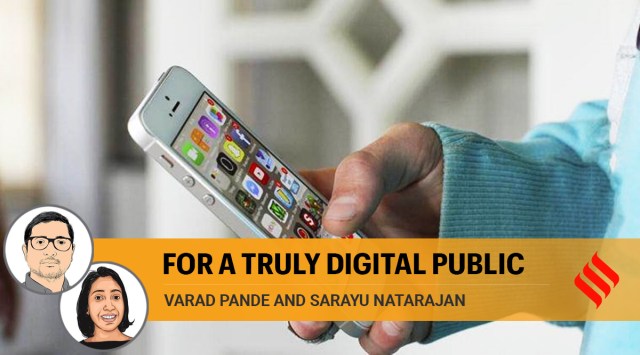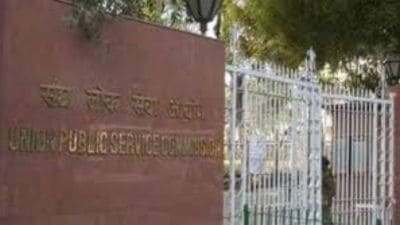- India
- International
How to create a truly digital public
Varad Pande, Sarayu Natarajan write: Technology must be designed with the people in mind.
 Recognising the power of technology to drive inclusion at a massive scale, the state is doubling down on technology to reach more citizens and serve them better.
Recognising the power of technology to drive inclusion at a massive scale, the state is doubling down on technology to reach more citizens and serve them better.Deepak, a plumber, lives on the outskirts of Lucknow and doesn’t have a smartphone. A friend offered to help him register for a Covid-19 vaccine on the CoWin portal. He refused, saying, “I am waiting for the panchayat to organise this; our leader wants us to take it from there.
If I take it from elsewhere, who will believe me?” When told not to worry as the CoWin portal will provide a digital certificate, he said: “You think anyone believes that? People will think I am faking it!” Deepak’s is a story of many Indians. As our society gets increasingly digitalised, it is bringing both exciting avenues for greater inclusion and innovation, but also exacerbating risks of exclusion.
Recognising the power of technology to drive inclusion at a massive scale, the state is doubling down on technology to reach more citizens and serve them better. From receiving vaccines and rations to paying for cooking gas and applying for fertiliser subsidies, “GovTech” is permeating the life of the ordinary Indian in unprecedented ways.
However, often the paradigm of technology for such services is built around the “elite” citizen, who is comfortable with technology. Often, this imagined citizen is male, urban, upper class. The term used in law, un-ironically, is “reasonable man”.
But we see that this conception is limited: Large segments of Indians still can’t access or haven’t learned to trust digital artefacts. Examples abound: The term “shopping cart” is unfamiliar to a vast number of users inhibiting access, and the “gender digital divide” mediates women’s access to technology with women social commerce entrepreneurs struggling to reap the benefits of platform tech.

Research by Aapti Institute in collaboration with eGovernments Foundation and Omidyar Network India has shown that many among marginalised groups struggle to access digital civic platforms, and instead rely on trusted human intermediaries.
All these examples demonstrate that we need more work to “make digital spaces truly public” — where all citizens and users can engage, claim and negotiate with technology, equitably and securely. We believe that at least three key elements need to come together to make the “digital public” a reality.
First, design with the citizen. This means understanding socio-cultural contexts and lived realities before designing tech solutions and doing so in a participatory manner. This is a shift from the default “build first and then disseminate” approach.
 For example, formative research and human-centric design was informative in the creation of the first UPI payments app, BHIM, whose simple interface and onboarding, use of relatable iconography and multi-language capabilities played an important role in early adoption of UPI among non “digital natives”.
For example, formative research and human-centric design was informative in the creation of the first UPI payments app, BHIM, whose simple interface and onboarding, use of relatable iconography and multi-language capabilities played an important role in early adoption of UPI among non “digital natives”.
Similarly, as the “Human Account” project demonstrated, it is possible to start with users in designing pro-poor fintech products, like the “Postman Savings” product which India Post Payments Bank designed for the rural poor. Encouraging human-centric design, and mandating user-assessments prior to roll out of GovTech platforms should be a key priority.
Second, harness the trusted human interface to serve those who are not comfortable with technology. Local intermediaries, such as formal and informal community leaders and civil society organisations, can play a key role in bridging the digital divide.
They provide the “trust layer” for the most marginalised, handholding them through everything from filling online application forms to accessing grievance redress system. Working with existing networks (for example ASHAs) or carefully setting them up (such as the Andhra Pradesh Ward Secretariat programme), where pre-existing trust, community knowledge, and embeddedness can play a significant role, should be prioritised.
Third, institutionalise an anchor entity that brings together innovators, policy makers and researchers to push the frontier on citizen-centricity in GovTech. Such a platform — like the Citizen Lab in Denmark — can play a role in generating formative research, embedding this research in practice by partnering with the government as well as market innovators, and working with civil society organisations to enhance access to GovTech.
As India makes rapid strides in its digitalisation journey, it is timely to invoke Gandhiji’s talisman and ensure that GovTech can serve its highest and greatest purpose, that is, serving those who are last in line.
This column first appeared in the print edition on October 30, 2021 under the title ‘For a truly digital public’. Pande is a partner at Omidyar Network India and Natarajan is the Founder of the Aapti Institute
40 Years Ago
EXPRESS OPINION
More Explained
Apr 16: Latest News
- 01
- 02
- 03
- 04
- 05









































